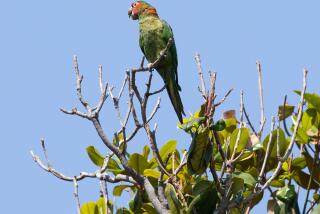Parrot Pairs
- Share via
HE WAS A yellow-headed Amazon. She was of mixed background, one of her parents a yellow-head, the other a red-crowned Amazon. No one knows where she came from, according to Jeffrey Froke, the man who studied Los Angeles parrots, but no matter. She grew up and fell in love with her yellow-headed mate, he with her.
They spent virtually all their time together. When foraging for food, they always stayed close to each other. At night they slept side by side. They even flew in close proximity when the flock was traveling. All the other parrots were equally committed; in fact, a parrot flock is actually a collection of pairs, not a group of individuals as it is with starlings, say, or shore birds.
But in the matter of communication, they took togetherness to an extreme known only in Shakespearean plays. All day long, as they went about their business, they chattered continuously with each other in a pattern known as “antiphonal duetting.” One would begin a call, the other would complete it. When calling close by, they sounded like one bird. When farther apart, they sounded like one stereophonic bird. Either way, the technique had the practical function of a safety check: “I know you’re there. You know I’m here,” while the flock foraged in the dense foliage where it’s easy to lose sight of one another. This is standard behavior for Amazons of all kinds.
The couple was never fully accepted by yellow-headed society; they spent their time on the fringes of the flock. She, using her mimicking skills, adopted the calls and language of the yellow-headed majority, but when a neighboring flock of red-crowns flew over, her kindred genes seemed to awaken and she called back in the speech of her other parent.
Despite the hardships, the pair endured. When last spotted in the West Los Angeles area, they had been together for at least 20 years.
More to Read
Sign up for Essential California
The most important California stories and recommendations in your inbox every morning.
You may occasionally receive promotional content from the Los Angeles Times.













